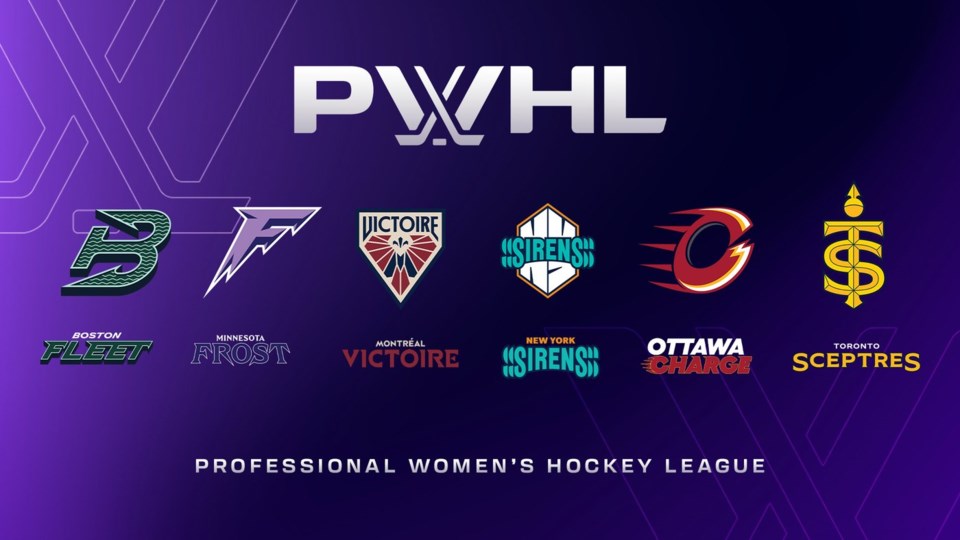The Professional Women’s Hockey League’s team names and logos have finally arrived.
After a season of canvassing fans, players and general managers, the PWHL unveiled long-awaited branding for all six franchises on Monday.
The Boston Fleet, Minnesota Frost, Montréal Victoire, New York Sirens, Ottawa Charge and Toronto Sceptres will take the ice when the league enters its second season.
"It's a super exciting day, not only for the players to finally be able to say that we play on the Sceptres — it's a lot easier to say than PWHL Toronto, so that's a plus for us,” Sceptres captain Blayre Turnbull said on a conference call after the announcement.
“But I think in terms of where the league's at and how successful it was last year without any names or logos, thinking to what the future holds now for all the teams and the franchises to have names and have logos and potentially mascots and so many different things for the fans to rally behind.”
The PWHL shattered women's hockey attendance records in a short-notice first year after the league was founded in June 2023.
Teams filled arenas without nicknames during the inaugural season from last January to late May, with only city names stitched across each team’s jerseys.
Now they’ll enter Year 2 with a whole new look.
The Boston Fleet’s name is intended to reflect the city’s maritime history, with a logo featuring a green “B” shaped like an anchor.
The Minnesota Frost logo showcases a sharp-edged “F” resembling icicles, highlighting the state’s famously cold winters.
The Montréal Victoire’s crest features “Victoire” in capital letters above a winged figure the league says alludes to the Goddess of Victory. The logo also has a hidden “M” and the Fleur-de-lis, Quebec’s national symbol, at its centre.
League executives said they purposely decided to keep the name in French, without an English translation.
“Really love the logo, really love the name,” Victoire captain Marie-Philip Poulin said, adding she found out about the name Sunday night. “When you come to the rink, it's going to be on the jumbotron. It's going to be everywhere. It's going to be on T-shirts, sweaters.
“Such an exciting day here today to have six new names, six new logos.”
In New York, “Sirens” represents the sounds of the city and a hockey goal horn. The logo has the word “Sirens” in teal running through the big white “NY” letters meant to symbolize the city’s skyscrapers.
The Ottawa Charge name references the city’s motto — “Advance — Ottawa — En Avant.” The emblem is a red “O” with spikes trailing along its side to suggest momentum. A slight gap in the “O” also allows it to be interpreted as a “C.”
“It's really exciting for our fan bases,” Charge captain Brianne Jenner said. “To see our jerseys in the stands like we're going to see this year, I think it's just the next step forward for our league.”
“Sceptres” is a nod to Toronto’s nickname as the Queen City and “Toronto’s regal history.” The logo combines the initials “T” and “S” in golden letters to form a sceptre — a symbolic staff often held by monarchs.
Jerseys will be released in late October or early November. All teams will retain their primary colours from last season while introducing additional secondary colours.
PWHL vice president of brand and marketing Kanan Bhatt-Shah led the naming process alongside PWHL senior vice president of business operations Amy Scheer. They partnered with creative agency Flower Shop to develop the names and logos.
The months-long search for team identities started the day the league was founded, but the turnaround had to be quick.
"Most teams take 18 months to do one logo, one team name," Scheer said. "We decided that we were going to do six in nine months."
League marketers set up criteria to ensure that the names represented each city, resonated with fans and were marketable.
From there, they gathered opinions from around the league — including players — and sought input from fans.
Bhatt-Shah said she followed PWHL games while they streamed on YouTube and saw “a lot of awesome stuff there to mine from.”
And with the league already underway, they had the benefit of visiting arenas across the league to chat with fans face-to-face.
”We had such a tremendous amount of input and insights and that we were also constantly mining, like at games, right?” Bhatt-Shah said. “We had the luxury and the privilege of actually being in market as this process was happening on a parallel path.”
Fans eagerly awaited the names. Last October, the PWHL filed applications to trademark six of them: Toronto Torch, Montreal Echo, Ottawa Alert, Minnesota Superior, Boston Wicked and New York Sound.
Some fans on social media speculated as recently as last week that those would be the names revealed on Monday. But Scheer said they were one of many.
“There's been hundreds upon hundreds of names that have been under consideration and have been trademarked for various purposes along our path,” Scheer said. “Those were just six that happened to have gotten out.”
Scheer said a small PWHL committee met daily to review names they secured the rights to, a challenge considering the hurdles of passing through intellectual property regulations in both Canada and the U.S.
They submitted names to the PWHL Advisory Board for approval ahead of a jersey artwork deadline in May.
Since then, they’ve been designing merchandise, websites and branding for all six markets with Monday's announcement in sight.
A schedule for the upcoming season has yet to be released, though play will begin earlier than last season’s Jan. 1 start date. The regular season will increase to 30 games from 24.
This report by The Canadian Press was first published Sept. 9, 2024.
Daniel Rainbird, The Canadian Press



